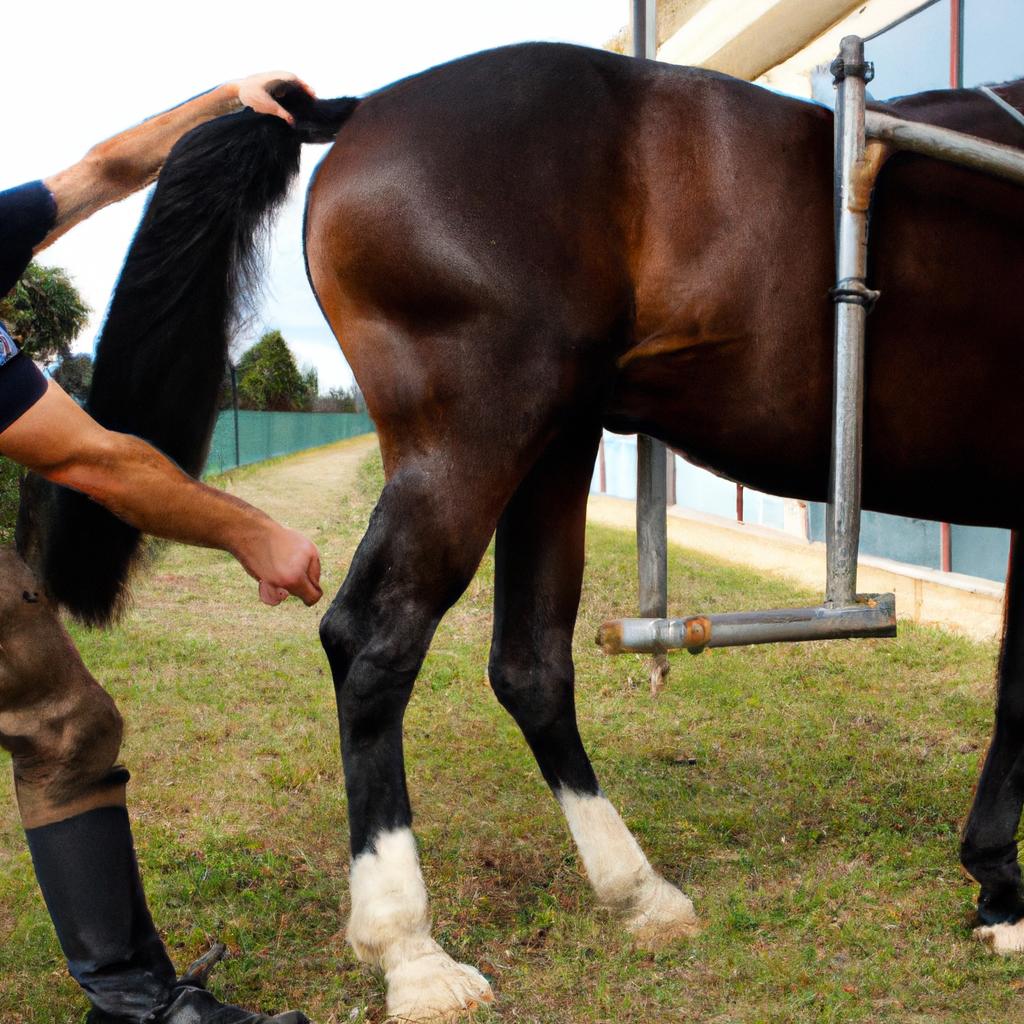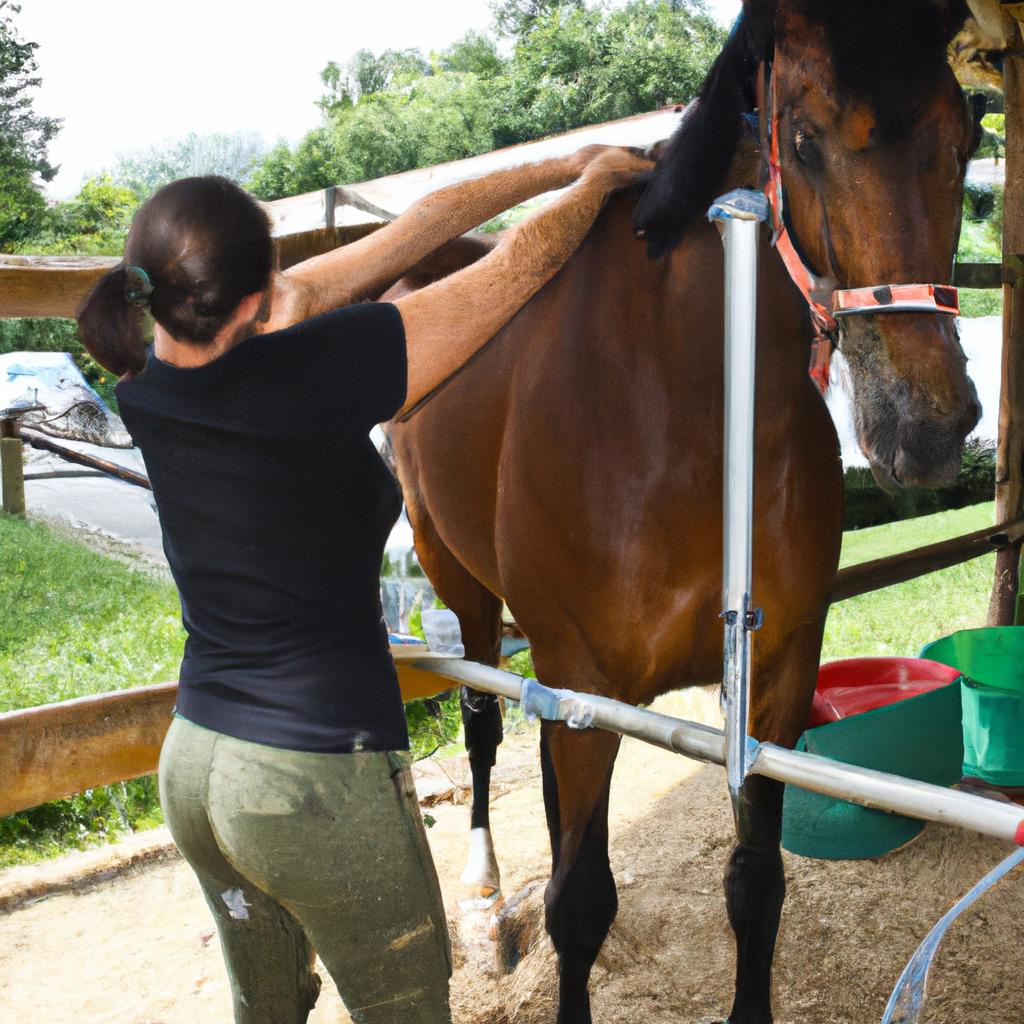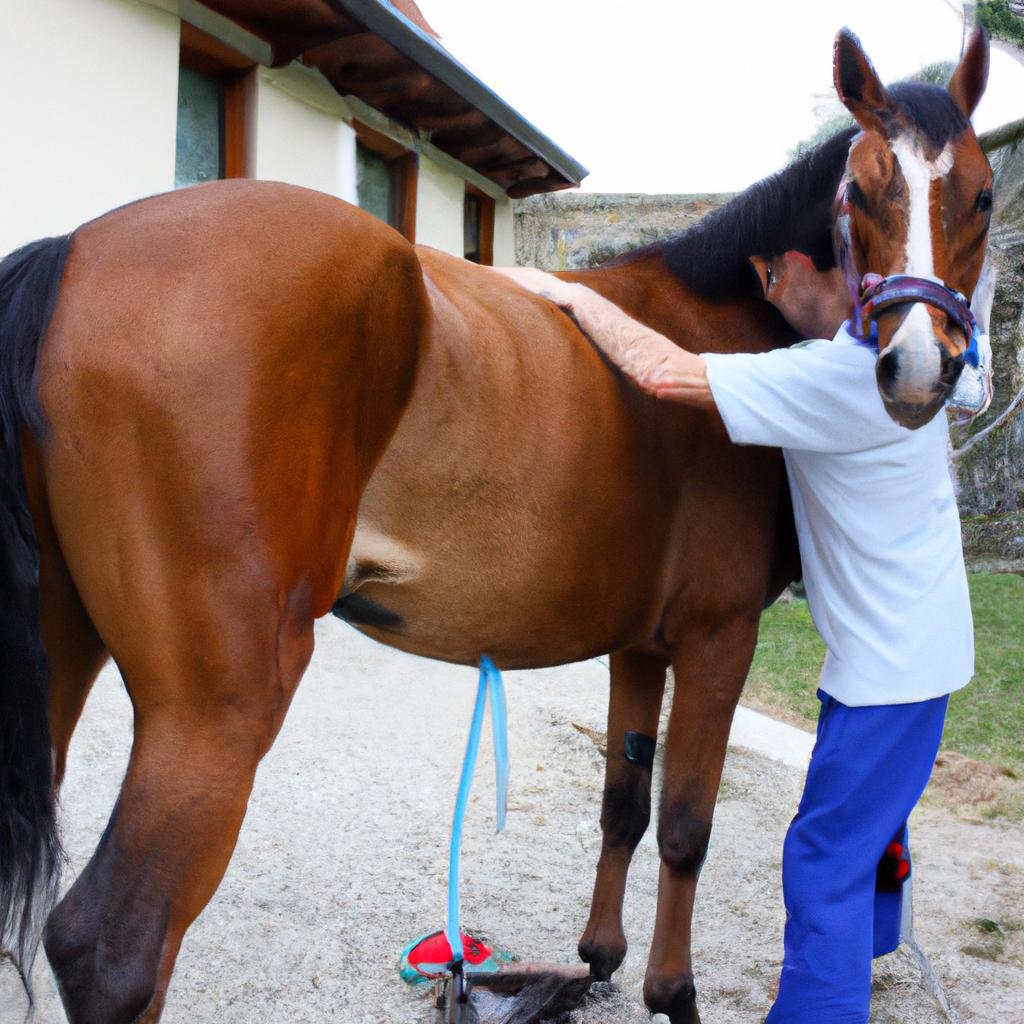Joint stiffness is a prevalent condition commonly treated in equine chiropractic practice. Horses, like any other athletes, are prone to developing joint stiffness due to various factors such as age, repetitive stress, and trauma. For instance, consider the case of a 10-year-old racehorse that has been experiencing decreased range of motion and difficulty performing certain maneuvers. Upon examination by a skilled equine chiropractor, it was discovered that the horse had developed joint stiffness in its hock joints as a result of wear and tear from years of rigorous training. This example highlights the significance of understanding common conditions related to joint stiffness in horses and the potential benefits of chiropractic intervention.
In order to effectively address joint stiffness in horses through chiropractic care, it is essential to have knowledge about the underlying causes and appropriate treatment techniques. Common conditions associated with joint stiffness include osteoarthritis, synovitis, ligament sprains, and muscle imbalances. Osteoarthritis is often observed in older horses or those who have experienced previous injuries or degenerative changes within their joints. Synovitis refers to inflammation of the synovial membrane surrounding joints, typically caused by overuse or traumatic injury. Ligament sprains can occur when there is excessive strain on the ligaments supporting the joints, leading to inflammation and stiffness. Muscle imbalances can also contribute to joint stiffness, as tight or weak muscles can disrupt proper joint alignment and function.
Treating joint stiffness in horses typically involves a combination of chiropractic adjustments, physical therapy exercises, and lifestyle modifications. Chiropractic adjustments aim to restore proper joint alignment and mobility by applying controlled force to specific areas of the spine or limbs. This helps alleviate pressure on affected joints and promotes improved range of motion.
Physical therapy exercises are crucial for strengthening muscles surrounding the affected joints and improving overall flexibility. These exercises may include stretches, range of motion exercises, and targeted strength training routines. It is important to work with a qualified equine therapist or trainer who can guide you in implementing an appropriate exercise program based on your horse’s specific needs.
Lifestyle modifications may also be necessary to prevent further joint stiffness or exacerbation of existing conditions. This may involve adjusting training methods, providing adequate rest periods between intense workouts, ensuring proper nutrition for optimal joint health, and addressing any underlying biomechanical issues that contribute to joint stress.
Regular monitoring and follow-up evaluations with an equine chiropractor are essential for assessing progress and making any necessary adjustments to the treatment plan. Additionally, it is important to involve other healthcare professionals such as veterinarians or farriers when needed for comprehensive management of joint stiffness in horses.
Overall, addressing joint stiffness in horses through chiropractic care requires a holistic approach that considers the underlying causes, incorporates appropriate treatment techniques, and pays attention to lifestyle factors. With proper care and management, many horses experiencing joint stiffness can regain comfort and functionality in their daily activities and athletic pursuits.
Definition of Joint Stiffness in Horses
Definition of Joint Stiffness in Horses
Imagine a scenario where a horse suddenly exhibits difficulty in moving its limbs or experiences resistance when attempting to perform certain movements. This could be indicative of joint stiffness, a common condition that affects horses and can significantly impact their overall well-being. Joint stiffness refers to the restriction in range of motion within one or more joints, leading to decreased flexibility and mobility. In order to fully understand this condition and its implications for equine health, it is essential to explore its definition, causes, and potential treatment options.
To delve into the concept of joint stiffness in horses, it is important to consider some key characteristics associated with this condition. First and foremost, joint stiffness often manifests as a result of underlying issues such as inflammation or injury affecting the structures within the joint. It may involve any joint in the horse’s body, including those found in the limbs (such as knees, hocks, fetlocks) or even spinal joints. The severity of joint stiffness can vary from mild discomfort during movement to complete immobility and lameness.
Understanding the impact that joint stiffness has on a horse’s physical capabilities can evoke an emotional response among owners who deeply care about their animal’s well-being. Some potential effects include:
- Limited athletic performance: Joint stiffness restricts a horse’s ability to engage in various activities such as jumping over obstacles or executing precise maneuvers required in competitions.
- Discomfort and pain: Horses experiencing joint stiffness may exhibit signs of discomfort such as reluctance to move or changes in behavior due to pain.
- Reduced quality of life: Restricted range of motion resulting from joint stiffness can limit a horse’s ability to fulfill natural behaviors like grazing freely or engaging in social interactions.
- Financial burden: Treating chronic cases of joint stiffness may require ongoing veterinary care and specialized therapies which can quickly accumulate substantial costs for owners.
| Effects | Description |
|---|---|
| Limited athletic performance | Joint stiffness hampers a horse’s ability to perform tasks requiring agility and precision, such as jumping or dressage. |
| Discomfort and pain | Horses with joint stiffness often exhibit signs of discomfort, including lameness, reluctance to move, and behavioral changes. |
| Reduced quality of life | Restricted range of motion can hinder a horse’s natural behaviors, impacting its overall well-being and social interactions. |
| Financial burden | Treating chronic cases of joint stiffness may lead to significant veterinary expenses for owners. |
In conclusion, joint stiffness in horses is characterized by limited range of motion within one or more joints, resulting from underlying factors such as inflammation or injury. This condition can have far-reaching effects on the affected horse’s physical capabilities, comfort level, quality of life, and financial implications for owners. In the subsequent section about “Causes of Joint Stiffness in Horses,” we will explore the various factors that contribute to this condition.
[Note: Markdown format has been used for the bullet point list above]
Causes of Joint Stiffness in Horses
Section H2: Causes of Joint Stiffness in Horses
Example Case Study: Imagine a scenario where a competitive show jumper, named Bella, has been experiencing joint stiffness in her hind legs. Despite receiving regular chiropractic care and having no previous history of lameness or injury, Bella’s performance has gradually declined. Upon further examination by a veterinarian specializing in equine health, it was discovered that the joint stiffness in Bella’s hind legs could be attributed to several underlying causes.
There are various factors that can contribute to joint stiffness in horses. These causes can range from acute injuries to chronic conditions:
- Trauma: Sudden impact or trauma to the joints can lead to swelling and inflammation, causing stiffness.
- Overuse: Repetitive strain on joints due to excessive exercise or improper training techniques can result in wear and tear over time.
- Arthritis: Degenerative joint disease such as osteoarthritis is common among older horses and can cause gradual stiffness.
- Synovial Fluid Imbalance: An inadequate production of synovial fluid, which lubricates the joints, can lead to increased friction and stiffness.
To better understand these causes, let us take a closer look at their effects on the horse’s joints:
| Causes | Effects | |
|---|---|---|
| 1 | Trauma | Swelling and inflammation |
| 2 | Overuse | Wear and tear |
| 3 | Arthritis | Gradual degeneration |
| 4 | Synovial Fluid Imbalance | Increased friction |
As you can see from this table, each cause has distinct effects on the affected horse’s joints. This information not only provides insight into why joint stiffness occurs but also highlights the importance of identifying the specific cause when developing an effective treatment plan.
Identifying the cause of joint stiffness is crucial in order to provide appropriate chiropractic care for horses. By understanding the underlying factors contributing to joint stiffness, veterinarians and chiropractors can tailor their treatment approaches accordingly. In the subsequent section about “Diagnosing Joint Stiffness in Horses,” we will explore the various steps involved in diagnosing this condition.
[Transition to next section] Through careful examination and diagnostic procedures, healthcare professionals can gain valuable insights into a horse’s joint health and determine the most suitable course of action to alleviate joint stiffness.
Diagnosing Joint Stiffness in Horses
Joint stiffness in horses can be caused by a variety of factors, including injuries, arthritis, and poor conformation. It is important for horse owners and trainers to understand the common conditions that can lead to joint stiffness in order to properly diagnose and treat these issues. By addressing the underlying causes of joint stiffness, chiropractors can help improve the overall well-being of horses.
One example of a condition that can cause joint stiffness in horses is osteoarthritis. Osteoarthritis occurs when there is damage or degeneration within a joint, leading to inflammation and pain. This condition commonly affects older horses but can also occur in younger animals due to trauma or other factors.
- Traumatic injuries: Falls or collisions can result in sprains or fractures, which may lead to joint stiffness.
- Overuse: Excessive training or competing without proper rest periods can put excessive strain on joints, leading to inflammation and stiffness.
- Poor conformation: Horses with structural abnormalities may experience increased stress on certain joints, resulting in long-term stiffness.
- Inflammatory diseases: Conditions such as synovitis (inflammation of the synovial membrane) or infectious arthritis can cause joint swelling and limited range of motion.
The table below provides an overview of some common conditions that contribute to joint stiffness in horses:
| Condition | Description | Prevalence |
|---|---|---|
| Osteochondritis | Developmental disorder affecting cartilage formation | Common |
| Degenerative Joint Disease | Progressive deterioration of cartilage | Moderate |
| Contracted Tendons | Shortening and tightening of tendons causing restricted movement | Rare |
| Bog Spavin | Abnormal enlargement of hock joints | Uncommon |
Understanding the various causes and prevalence of joint stiffness in horses is crucial for diagnosing the condition accurately and determining the most appropriate treatment.
Transitioning into the subsequent section about “Chiropractic Techniques for Treating Joint Stiffness in Horses,” it becomes evident that proper diagnosis is essential before initiating any therapeutic interventions.
Chiropractic Techniques for Treating Joint Stiffness in Horses
Diagnosing Joint Stiffness in Horses is an essential step towards providing effective chiropractic treatment. By identifying the specific condition causing joint stiffness, veterinarians and chiropractors can develop targeted treatment plans to alleviate discomfort and restore mobility. Let’s explore some common conditions that are often diagnosed in horses presenting with joint stiffness.
One example of a condition frequently seen in horses with joint stiffness is osteoarthritis. This degenerative joint disease commonly affects older animals but can also occur due to trauma or repetitive stress on the joints. Osteoarthritis causes inflammation, pain, and reduced range of motion in the affected joints, leading to stiffness and difficulty moving.
Other conditions that can contribute to joint stiffness include synovitis, which involves inflammation of the synovial membrane lining the joints, as well as tendonitis and bursitis, which both involve inflammation of tendons and bursae respectively. These conditions may result from overuse or traumatic injuries and can cause significant discomfort for the horse.
- Chronic pain: Joint stiffness can lead to chronic pain in horses, affecting their quality of life.
- Limited mobility: Restricted movement caused by stiff joints can hinder a horse’s ability to engage in regular activities such as exercise or grazing freely.
- Decreased performance: Joint stiffness may significantly impede a horse’s athletic abilities, hindering their performance during competitions or training sessions.
- Emotional distress: The constant discomfort experienced by horses with joint stiffness can lead to anxiety or behavioral changes.
In addition to understanding these emotional implications, it is vital to recognize how different conditions affect various areas within equine anatomy. Consider this three-column table highlighting examples of common diagnoses associated with joint stiffness:
| Condition | Affected Area |
|---|---|
| Osteoarthritis | Hock, knee, and fetlock |
| Synovitis | Stifle joint |
| Tendonitis | Flexor tendons |
| Bursitis | Olecranon bursa |
By diagnosing these conditions accurately, veterinarians and chiropractors can tailor their treatment plans to address the specific needs of each horse. This targeted approach helps ensure that the underlying causes of joint stiffness are effectively addressed, leading to improved overall well-being for the equine patients.
Transitioning into the subsequent section about “Benefits of Chiropractic Care for Joint Stiffness in Horses,” it becomes evident that understanding the diagnosis plays a crucial role in designing effective chiropractic techniques. By applying specialized adjustments and therapies tailored to each condition, chiropractors can alleviate joint stiffness and promote optimal mobility, as we will explore in the following section.
Benefits of Chiropractic Care for Joint Stiffness in Horses
One notable case study that highlights the effectiveness of chiropractic care in treating joint stiffness is the story of a 10-year-old Thoroughbred named Luna. Luna had been experiencing significant joint stiffness in her hind legs, affecting both her performance and overall well-being. After multiple unsuccessful attempts to alleviate her discomfort through traditional methods, Luna’s owner sought out chiropractic treatment as a last resort.
The first step in addressing Luna’s joint stiffness was a thorough examination by a qualified equine chiropractor. This involved assessing her posture, range of motion, and spinal alignment. The examination revealed misalignments or subluxations in several areas of Luna’s spine, particularly focusing on the lumbar region.
To address these issues, the chiropractor utilized various techniques specifically tailored to horses with joint stiffness. These included gentle adjustments, mobilizations, and soft tissue therapies designed to relieve tension and restore proper alignment. Over a series of treatments, Luna experienced gradual improvement in her mobility and decreased levels of pain.
The positive outcome observed in cases like Luna’s showcases the potential benefits of chiropractic care for horses with joint stiffness. By targeting the root cause rather than solely managing symptoms, chiropractors can help improve overall musculoskeletal health and enhance athletic performance. Some key advantages include:
- Non-invasive approach: Chiropractic techniques offer a drug-free alternative for managing joint stiffness.
- Individualized treatment plans: Each horse receives personalized care based on their specific needs.
- Holistic perspective: Chiropractors consider not only physical factors but also lifestyle and environmental influences when developing treatment strategies.
- Enhanced quality of life: By reducing pain and improving mobility, chiropractic care can contribute to an improved overall well-being for horses experiencing joint stiffness.
| Advantages of Chiropractic Care for Joint Stiffness |
|---|
| Non-invasive approach |
| Individualized treatment plans |
| Holistic perspective |
| Enhanced quality of life |
In summary, chiropractic techniques have shown promise in addressing joint stiffness in horses. By utilizing specific adjustments and therapies tailored to each individual’s needs, equine chiropractors can help alleviate discomfort, improve mobility, and enhance the overall well-being of affected animals.
Looking ahead to the next section on preventing joint stiffness in horses, it is crucial to understand proactive measures that can be taken to maintain optimal musculoskeletal health throughout a horse’s lifespan.
Preventing Joint Stiffness in Horses
Chiropractic care has proven to be highly beneficial in treating joint stiffness in horses. Through manual manipulation techniques, chiropractors can alleviate discomfort and restore proper joint function. This section will explore common conditions treated by chiropractic care and the positive outcomes that can be achieved.
One example that highlights the effectiveness of chiropractic care is a case study involving a 10-year-old Thoroughbred racehorse named Thunderbolt. Thunderbolt presented with signs of joint stiffness, including decreased range of motion and difficulty performing certain movements. After undergoing a series of chiropractic adjustments, Thunderbolt showed remarkable improvement in his flexibility and overall performance on the racetrack.
- Enhanced quality of life: By addressing joint stiffness early on through chiropractic care, horses can experience increased comfort and mobility.
- Improved athletic performance: Properly functioning joints are essential for optimal performance in various equestrian disciplines.
- Prevention of secondary issues: Untreated joint stiffness can lead to compensatory injuries or musculoskeletal imbalances, which can be avoided with regular chiropractic treatments.
- Holistic approach: Chiropractic care focuses on restoring balance and promoting overall well-being, contributing to an improved physical and mental state for the horse.
In addition to these advantages, it is important to understand some common conditions that respond well to chiropractic interventions. The table below provides an overview of such conditions along with their typical symptoms:
| Condition | Symptoms |
|---|---|
| Osteoarthritis | Joint pain, swelling |
| Sacroiliac Dysfunction | Hind limb lameness |
| Cervical Misalignment | Difficulty bending neck |
| TMJ Disorder | Jaw clicking or locking |
By targeting specific conditions through chiropractic care, veterinarians and horse owners can effectively address joint stiffness and its associated symptoms. Ultimately, this approach leads to improved well-being and performance for horses.
In summary, chiropractic care has proven to be highly advantageous in treating joint stiffness in horses. Through manual manipulation techniques, common conditions such as osteoarthritis, sacroiliac dysfunction, cervical misalignment, and TMJ disorder can be successfully addressed. By enhancing the quality of life and athletic performance while preventing secondary issues, chiropractic care provides a holistic approach that benefits both the physical and mental state of the horse.
 Eq Muscle Release
Eq Muscle Release



